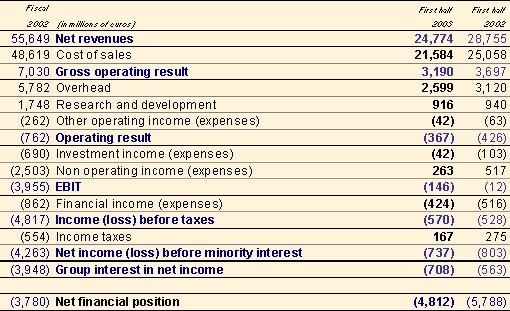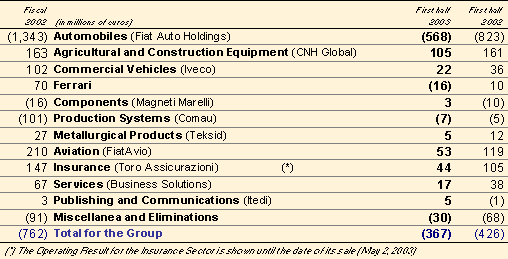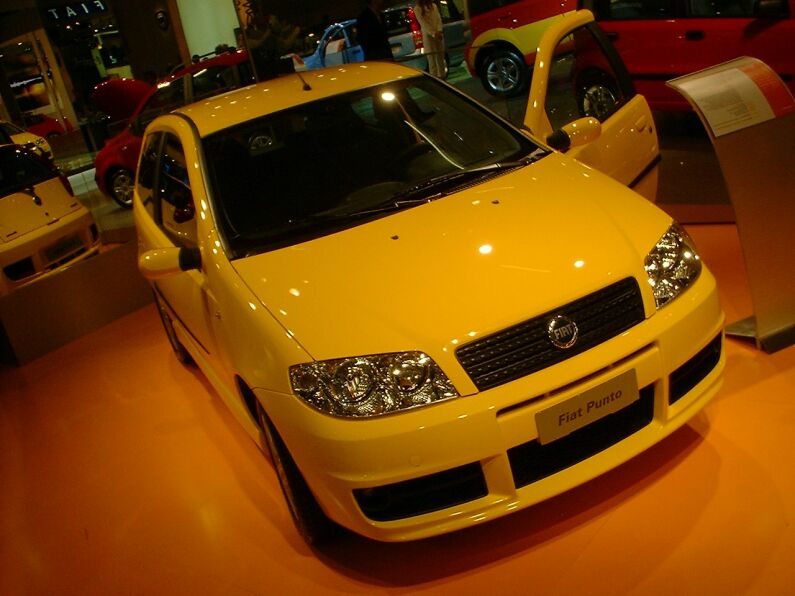12.09.2003 FIAT BOARD APPROVE AND RELEASE THE GROUP'S HALF YEARLY REPORT
FIAT SPA, TURIN: The Board of Directors of Fiat S.p.A., meeting in Turin under the chairmanship of Umberto Agnelli, approved the Group’s Half-yearly Report. The operating and financial data contained in the Report were published previously, after being reviewed by the Board of Directors at its meeting of July 31, 2003.
Key Developments
Despite the weakness and uncertainty that marked the world markets during the first half of 2003 — and which are continuing to affect business conditions — the Fiat Group posted improvements in the key indicators of its operating and financial performance, making progress toward achieving its stated year-end financial improvement and debt reduction goals.
This achievement is the net result of two periods that were characterized by markedly different performances. A difficult first quarter, with results penalized by the problems that affected the Group in 2002, was followed by a second quarter during which the benefits that Fiat Auto’s restructuring program is beginning to produce and the acceleration of the divestiture process yielded significantly better results than both the same period last year and the first quarter of 2003.
During the first half of this year, the Group presented its Industrial and Financial Relaunch Plan, which provided clear guidelines for all Company initiatives. The Plan calls for operating income to rise to more than 4% of revenues by 2006. This improvement will be the result of 3.1 billion euros in cost reductions and 1.6 billion euros in increased margins from new products, net of a 1.8-billion-euro rise in expenses.
The principal initiatives taken earlier this year to strengthen the Group’s balance sheet were a capital increase of about 1.8 billion euros, which was approved by the Board of Directors of Fiat S.p.A. in June 2003 and completed successfully during the first half of August, and the divestitures of businesses that no longer fit within the strategic scope of operations as defined in the Plan.
The main divestitures included:
- The sale of
Toro Assicurazioni to the DeAgostini Group;
- The signing
of an agreement to sell FiatAvio’s aerospace operations to the Carlyle
Group and Finmeccanica;
- The disposal
of Fiat Auto’s retail financing operations;
- Iveco’s sale
of Fraikin, a provider of long-term rental services for commercial vehicles,
to Eurazeo;
- The sale of
a controlling interest in IPI S.p.A., a company that specializes in developing,
managing and marketing large real estate portfolios, to the Zunino Group.
Performance for the first half of 2003
Consolidated Group revenues totaled 24,774 million euros in the first half of 2003, down from 28,755 million euros in the same period last year. Divestitures were partly responsible for this 13.8% decline. On a comparable consolidation basis, revenues show a decrease of about 8%. Other negative factors include lower unit sales by Fiat Auto and the negative impact of a strong euro on foreign exchange translations (especially with respect to the U.S. dollar), which was particularly penalizing for CNH. Net of the changes in the scope of consolidation caused by divestitures, Iveco had revenues in line with the first six months of 2002. Ferrari, Comau and Business Solutions posted revenue gains.
The operating result was negative by 367 million euros. This loss, most of which was incurred in the first quarter (-342 million euros), is lower than the 426 million euros posted in the first half of 2002. When the data are restated on a comparable consolidation basis, the year-over-year improvement amounts to 110 million euros. The reduction in operating loss is attributable almost entirely to the improved performance turned in by Fiat Auto in the face of challenging market conditions.
The consolidated net loss (also incurred primarily in the first quarter) amounted to 737 million euros, compared with a loss of 803 million euros in the first six months of 2002. A smaller operating loss, a decrease in net financial expenses made possible by lower indebtedness and interest rates, income from equity investments, and the net gain from the sale of Toro Assicurazioni (279 million euros) account for this improvement. Also, it is worth noting that, compared with this year, the figure for 2002 benefited from higher extraordinary income, including the gain of 547 million euros earned on the sale of a 34% interest in Ferrari.
At June 30, 2003, the net financial position was negative by 4,812 million euros, with an improvement of about 1 billion euros compared with June 30, 2002. However, indebtedness was higher when compared with December 31, 2002 (-3,780 million euros) due to the net loss for the period, an increase in working capital and a decrease in discounted receivables. These developments, which occurred primarily in the first quarter, produced an increase in liquidity needs that could be met only in part through divestitures.
Performance of the Principal Sectors:
Fiat Auto
During the first half of 2003, the Western European automobile market (about 7.5 million cars sold) contracted by an average of 2.6% compared with the same period last year. The largest decreases occurred in France (7.8%), Belgium (9.9%) and Portugal (23%). In Italy, demand held relatively steady at a little more than 1,200,000 units. Sales results were uneven outside Western Europe, with shipments down sharply (-8.8%) in Brazil, but up 13.5% in Poland and 80% in China. Similar patterns characterized the market for light commercial vehicles.
In this market environment, Fiat Auto had revenues of 10,149 million euros in the first six months of 2003, compared with 11,770 million euros in the same period a year ago. Fiat Auto sold 867,100 automobiles and light commercial vehicles worldwide, or 12.7% less than in the first half of 2002. Weak demand in the Sector’s key markets, a marketing strategy focused on improving the quality of sales even at the expense of sales volumes, the aggressive sales policies pursued by the competition and Fiat Auto’s aging product line account for this decrease. The process of renewing the Sector’s model lineup, which got under way in June with the commercial launch of the Nuova Punto and Nuova Alfa 156, is accelerating as the year progresses. The first half of September will see the introduction of the Lancia Ypsilon and Nuova Panda, followed by the Nuova Alfa 166, the Fiat Idea and the Alfa GT. Another negative factor that limited sales during the first six months of 2003 was the production shortfall caused by a flood at the Termoli engine plant in January.
At June 30, 2003, Fiat Auto’s share of the automobile market stood at 28.2% in Italy (3.4 percentage points less than in the same period last year) and 7.6% in all of Western Europe (down 0.9 percentage points compared with the first six months of 2002). In the area of light commercial vehicles, the Sector’s market share increased by 0.9 percentage points in Italy (Fiat Auto controlled over 44% of the market), but declined to 11.5% in Western Europe, down slightly from 12.1% in the first half of 2002.
Fiat Auto reported an operating loss of 568 million euros, an amount significantly smaller than the loss of 823 million euros recorded the first six months of 2002. This improvement can be attributed primarily to cost-cutting programs, which benefited to a major extent from the synergies generated by the industrial alliance with General Motors.
Despite the shortfall in revenues, Fiat Auto slightly increased its R&D spending during the first half of 2003.
CNH Global
The world market for agricultural equipment grew during the first six months of 2003, expanding by 8% overall compared with the same period last year. Demand was down in Western Europe (-2%), but increased in North America (+17%), Latin America (+4%) and the rest of the world (+12%).
During the same period, demand patterns for construction equipment followed diverging trends in the different markets, with shipments down 1% in Western Europe, 2% in North America and 17% in Latin America, but up 28% in the rest of the world.
CNH, which uses the U.S. dollar as its reporting currency, had revenues of $5,303 million in the first half of 2003, up from $5,104 million in the first half of 2002. Translated into euros, CNH’s revenues declined from 5,691 million euros in the first six months of 2002 to 4,800 million euros in the same period this year (-15.7%), due mainly to the strengthening of the euro versus the U.S. dollar. On a comparable foreign exchange translation basis, the decrease amounts to 5% and primarily reflects lower sales of construction equipment.
Unit sales of agricultural equipment held relatively steady, as declines in North and Latin America were offset by gains in the rest of the world. However, shipments of construction equipment were down 12%, with decreases affecting sales both of heavy equipment (which are more profitable) and light equipment.
CNH reported operating income of $116 million, compared with $144 million in the first half of 2002. When stated in euros, operating income declines to 105 million euros (161 million euros in the same period last year). Other negative factors that affected the Sector’s operating performance, in addition to the impact of a weak U.S. dollar, include lower unit sales of construction equipment, a less profitable sales mix and higher employee medical and retirement benefit costs.
Nevertheless, CNH’s profitability remained at a satisfactory level due to the improved margins earned on new models of agricultural equipment, the higher prices charged to customers and the significant cost savings made possible by newly developed synergies. The significant progress CNH made during the first six months of 2003 in integrating Case and New Holland produced benefits quantifiable at $59 million by decreasing overhead, lowering logistics costs and streamlining the supplier base and reducing the manufacturing facilities.
Additional savings should come from the continued implementation of cost-cutting programs and the introduction of new products with common components in the second half of the year. During this period, sales volumes should begin to benefit from the introduction of numerous new agricultural and construction equipment models during the first six months of this year.
IIveco
During the first half of 2003, the Western European market for commercial vehicles experienced a modest overall contraction of 0.5% in new registrations. Large decreases occurred in France (-6.7%) and especially in Italy (-12.6%), where the end of the incentives provided by the Tremonti Bis Law was a major negative factor. Compared with the first six months of 2002, demand was down in all market segments (-8.1% for intermediate vehicles and -0.8% for light vehicles) with the exception of heavy-load vehicles (+3.1%).
Iveco had revenues of 4,175 million euros in the first half of 2003, or 7.4% less than the 4,508 million euros booked in the same period a year ago. The sale of Fraikin and a change in the method used to consolidate Naveco (a joint venture with the Yueijin Group in China) are the main reasons for this decrease. On a comparable consolidation basis, revenues show little change from the first six months of 2002.
Operating income for the first half of 2003 declined to 22 million euros, compared with 36 million euros in the same period last year, due almost exclusively to changes in the scope of consolidation. On a comparable basis, this year’s figure is close to the amount earned in the first six months of 2002.
Ferrari
Ferrari’s revenues grew 6.3% to 624 million euros in the first half of 2003. Higher unit sales made possible by demand for the new products introduced last year (the 575M and, more importantly, the limited edition Enzo Ferrari) account for this improvement. However, the operating result was negative by 16 million euros (positive 10 million euros in the first six months of 2002) due to the increased R&D spending incurred to develop new Ferrari and Maserati models and the negative impact on currency translations of the appreciation of the euro versus the U.S. dollar.
Other sectors
Despite the negative impact of the difficult business conditions facing carmakers and an unfavorable dollar-euro exchange rate, the components Sectors posted good results overall.
Revenues were down 9.7% (-1.9% on a comparable consolidation and foreign exchange basis) at Magneti Marelli due to unfavorable exchange rates and weak demand from carmakers. However, the operating result improved from a loss of 10 million euros in the first half of 2002 to income of 3 million euros in the same period this year. This positive performance (the comparison is even better on a comparable consolidation basis) was made possible by the programs implemented to increase efficiency and cut costs.
Comau’s revenues rose 9.1% to 1,082 million euros, up from 992 million euros in the first six months of 2002. The Sector’s operating loss widened slightly (7 million euros, compared with 5 million euros in the first half of 2002), as a drop in contract work in Europe more than offset gains in North America.
Teksid had lower revenues (439 million euros in the first six months of 2003, compared with 950 million euros in the same period last year). On a comparable consolidation basis (excluding the impact of last year’s sale of the Aluminum Business Unit), revenues show a decrease of 8%, due mainly to unfavorable foreign exchange rates. At the Business Unit level, production volumes for Cast Iron were substantially in line with those recorded last year (-0.3%) and increased for Magnesium (+6.8%).
Operating income totaled 5 million euros, compared with 12 million euros in the first half of 2002 (operating loss of 3 million euros on a comparable scope of consolidation basis). The result achieved this year was made possible by reductions both in overhead and variable costs, which helped offset the negative impact of exchange rates on prices.
Business Solutions had revenues of 943 million euros in the first six months of 2003, for a gain of 2.3% over the same period last year. The decrease in operating income (17 million euros compared with 38 million euros in the first half of 2002) reflects the deconsolidation of IPI, which in 2002 contributed operating income of approximately 16 million euros.
Itedi increased its revenues by 5% to 190 million euros. Operating income rose to 5 million euros, compared with an operating loss of 1 million euros in the first six months of 2002. Gains in efficiency and the higher advertising revenues generated by Publikompass are the main reasons for this improvement.
Outlook for the balance of the year
During the balance of this year, the Fiat Group will continue to face a difficult and challenging environment. Nevertheless, it will press on, adhering to its schedule, with the important restructuring and cost-cutting programs it launched earlier this year.
The potential of the 2003-2006 Relaunch Plan, which is expected to begin producing major benefits in the last quarter of 2003, is already becoming apparent, particularly in terms of new product momentum. Dealer orders totaled more than 140,000 units for the Nuova Punto, 32,000 for the Nuova Panda and 15,000 for the Lancia Ypsilon. Before the end of the year, these new models, which have been well received both by the press and the public, will be followed by the Fiat Idea, Nuova Alfa 166 and Alfa GT.
Important financial
developments that have occurred since June 30, 2003 include the sale of
the aerospace operations of FiatAvio, which will produce an improvement
of
1.4 billion
euros in the Group’s net financial position, and the successful completion
of the capital increase approved by the Board of Directors on June 26,
2003. All ordinary Fiat shares available through the rights offering (367,197,108
shares) were subscribed without the intervention of the Underwriting Group,
generating proceeds of 1,836 million euros. CNH issued eight-year senior
notes with a face value of $750 million, later increased to $1,050 million.
Based on the current scenario, the Group expects to attain its stated objective of reporting by year’s end a significantly smaller operating loss and a healthier financial position than at the end of 2002.
|



